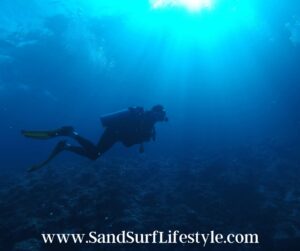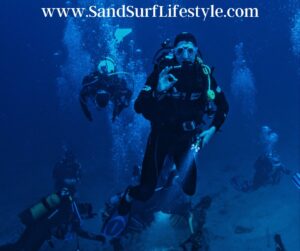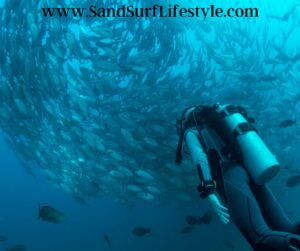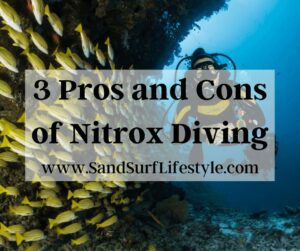3 Pros and Cons of Nitrox Diving
Scuba enthusiasts explore worlds that most people visit vicariously through social media postings. The vast world of ocean exploration literally surrounds us. With equipment changes and different mixtures of gases in your tank, the underwater voyage can be enjoyed for longer.
Diving with nitrox in your tanks presents positives and negatives to be considered. With professional training and the correct equipment, many recreational divers have chosen to switch their cylinders to nitrox blends.
The Pros and Cons of Nitrox Diving are:
Pros:
- Reduce Surface Breaks
- Extended Diving Time
- Reduced Lethargy
Cons:
- Oxygen Toxicity
- Change in Diving Depth
- Accessibility and Cost
Continue your discovery here for information on nitrox, its benefits, its negatives, and other aspects to consider. Our world is mainly the ocean, so grab your scuba gear, and let’s go diving.
What Is Nitrox and How Does It Work?
 Our air contains nitrogen and oxygen with small amounts of other gases. Scuba tanks contain a mixture to mimic our air, called atmospheric gas. This air is compressed in high-pressure cylinders, so you can take more air with you on your dive trips.
Our air contains nitrogen and oxygen with small amounts of other gases. Scuba tanks contain a mixture to mimic our air, called atmospheric gas. This air is compressed in high-pressure cylinders, so you can take more air with you on your dive trips.
Nitrox is combined with nitrogen and oxygen. It continues to become increasingly available to recreational divers. This variation on the atmospheric gas focuses on increasing the percentage of oxygen in the tank. Ranges of oxygen can vary from 22% to 40% of the total gas volume in nitrox mixtures.
EANx is an acronym used for nitrox combinations. Enriched is E, air is A, N is for nitrox. The X is the percentage of oxygen, and it is a variable because it can change depending upon the diver and their dive. Nitrox I and Nitrox II are the most common blends used by recreational divers.
Nitrox I is also Nitrox 32 since it has 32% oxygen and 68% nitrogen. Nitrox II is a blend of 36% oxygen and 64% nitrogen. Altering the mixture of oxygen and nitrogen allows divers more control over the potential negative impact of nitrogen on their bodies.
As you dive, your body absorbs the gases from your tank. Since your body is under increasing pressure, more gas dissolves in your blood and tissues than would on the surface. Underwater the nitrogen enters your bloodstream and tissues.
Nitrogen in your body can create problems especially when you ascend. As you ascend, the amount of pressure reduces. A rapid ascent can cause the formation of nitrogen bubbles. This bubbling out can create a blockage of your small blood vessels.
If you reduce the amount of nitrogen and increase oxygen, the risk of bubbles is diminished. Less nitrogen means your body does not have to work as hard. And the extra oxygen gives you more energy.
3 Key Reasons Divers Prefer Nitrox
With altering the mixture of gases, divers can spend more time exploring the wonders of the undersea world. Blended gases are becoming more common with recreational divers.
- Reduce Surface Breaks
The surface time between dives is necessary for your body to flush out the nitrogen in your system. Since nitrogen takes several hours to be completely released from your body, the breaks between dives lowers the amount of nitrogen in your system.
Therefore, if you reduce the amount of nitrogen in your tank, you can shorter the length of time out of the water between dives. So, when you are in a fabulous dive spot, you will get in more dives a day with nitrox.
- Extended Diving Time
 You are exploring a shipwreck, just as you were about to check another part of the ship, it is time to ascend. Since nitrox has less nitrogen, your dive times can be increased. With less nitrogen entering your system, you reduce your risk of decompression sickness or nitrogen narcosis.
You are exploring a shipwreck, just as you were about to check another part of the ship, it is time to ascend. Since nitrox has less nitrogen, your dive times can be increased. With less nitrogen entering your system, you reduce your risk of decompression sickness or nitrogen narcosis.
Decompression sickness, also commonly referred to as the bends, can be deadly. This is caused by nitrogen buildup in your body. If resurface too quickly, you may experience decompression sickness. Nitrox lowers the chance of suffering from decompression sickness.
- Reduced Lethargy
Many divers assert that using nitrox makes them feel less tired after a dive. While this has not been scientifically proven, stories from many divers perpetuate this claim. The theory postulated is that with lower nitrogen levels there is a reduction in the number of microbubbles in the diver’s bloodstream.
The microbubbles of nitrogen begin to block the diver’s blood vessels. Consequently, your body is working harder to pump blood. This increases your fatigue. Reducing the absorption of nitrogen and the number of bubbles, your circulatory system does not need to work tirelessly.
Do You Know What The Main Differences Between Snorkeling Fins and Diving Fins? Learn More Here.
3 Reasons Why Divers Are Concerned About Nitrox
Key reasons to use nitrox in your tanks have been explained. Increasing the percentage of oxygen does not come without its own risks.
- Oxygen Toxicity
Recreational divers breathing compressed gas will usually not have to worry about oxygen toxicity. In nitrox mixtures and an increase in the percent of oxygen, the possibility of oxygen toxicity is now a concern. Oxygen toxicity is the result of breathing in higher concentrations of oxygen than the 21% in the air.
However, this concern can be diminished by following your dive tables. Divers who exceed the time or depth on the dive table put themselves and their dive partners at risk. Thorough planning of your dive is essential. Calculate the safe mixture of nitrox for your excursion based on your diving depths.
- Change in Diving Depth
While your dive time is increased with nitrox, one offset is the depth of your dive. Because of the increase in oxygen and concerns about oxygen toxicity, you have a shallower limit. Depending upon the goals of your dive and dive location, this might not be a concern for you. It is important to adhere to the depths allowed with your nitrox formulation.
- Accessibility and Cost
 Nitrox is growing in acceptance in the diving community. As more divers use nitrox, it will become easier to find the equipment needed and gas blends you are seeking. Nitrox does cost more than compressed gas. You must calculate the intrinsic value of additional dive time and reduction in surface intervals for your total cost.
Nitrox is growing in acceptance in the diving community. As more divers use nitrox, it will become easier to find the equipment needed and gas blends you are seeking. Nitrox does cost more than compressed gas. You must calculate the intrinsic value of additional dive time and reduction in surface intervals for your total cost.
Other Considerations
Depending upon your perspective, the following could be positives or negatives. The plus is following guidelines will help protect you. The negative is that specialized equipment will cost more. Another plus is for the extra investment, you get a new and different diving experience.
- Specialized Equipment
For Nitrox, you will need tanks that are clearly labeled as Nitrox tanks. The percentage of oxygen in the mixture in the tank must be written near the tank’s valve. A gas analyzer is required, so you be certain of your nitrox mixture.
Special gear is needed because of the higher oxygen. Oxygen is flammable, so the handling and cleaning of nitrox tanks must be done to avoid explosion.
- Specialized Training
To achieve the benefits and purpose of nitrox, divers must learn to use it safely. Nitrox Diving Certification or Enriched Air Certifications will teach how to use the gas analyzer, handle tanks to avoid explosion, and use the dive computer.
Related Questions
Are there NOAA dive tables for Nitrox?
Yes, the National Oceanic and Atmospheric Administration has detailed dive tables for nitrox. Their tables will provide information for you on blends with oxygen ranging from 28% to 40%. Use your NOAA Dive Tables to calculate bottom time, surface intervals, and repetitive dives.
What is trimix?
Trimix is another special blend of gases. Trimix blends oxygen, nitrogen, and helium. Helium is added to permit deeper dives. Dives requiring a diver to descend more than 130 feet require trimix.

Please note: This blog post is for educational purposes only and does not constitute legal or medical advice. Please consult a legal expert or medical professional to address your specific needs.

